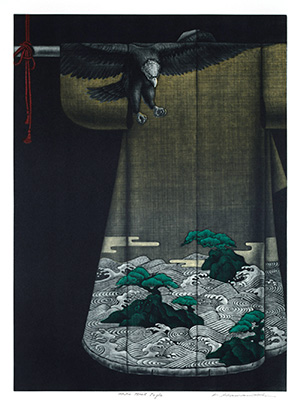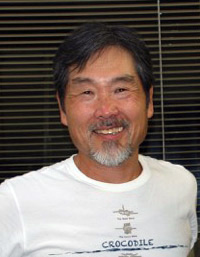In Japan the print has occupied a very important position as an art form. Over a long and distinguished career Katsunori Hamanishi has focused on the production of mezzotint prints, perhaps the most demanding of all print techniques. Hamanishi creates images with both subtle details and dynamic compositions that explore spatial relationships. His work is celebrated for balancing calm and meditative qualities with energetic tensions of inanimate and natural objects. There is a sense of mystery and intrigue in his prints.
Hamanishi was born on Hokkaido, Japan’s second largest island. In 1973, he finished his studies at Tokai University in Kanagawa prefecture. His work has been exhibited internationally in Paris, Belgium, Philadelphia, Tokyo, Kyoto, Cairo and San Francisco as well as in the Ibiza International Print Biennial and the Valparaiso International Exhibition, Chile. In 2012 The Art of Darkness opened at the Arthur M. Sackler Gallery in Washington DC featuring Hamanishi’s mezzotints along with those of Yozo Hamaguchi (he created Papillon Rouge, Publication Print No. 51 from 1973). In 2013 Hamanishi had a one-man show at the Art Institute of Chicago.
Hamanishi’s connection to Cleveland goes back to 1986 when printmaking professor H. Carroll Cassill invited him to come as a visiting artist at the Cleveland Institute of Art. At that time he was already a respected artist who had received prizes at renowned international exhibitions. Hamanishi remarked, “This wonderful and unforgettable experience at the Cleveland Institute of Art made it possible for me to visit the United States later. In 1987 the Japan Agency for Cultural Affairs selected me and sponsored my study in the U.S.”
Under that grant, Hamanishi studied at the University of Pennsylvania. He, his wife Tsuyako and their two sons stayed in Philadelphia for a year while he studied art and produced new work. Hamanishi returned to the Cleveland Institute of Art in 1998 and again in 2014 to conduct mezzotint demonstrations.
Hamanishi is at home with both Japanese and western art history although many of his subjects are borrowed from the Japanese tradition. His favorite themes are objects that can be shown three-dimensionally like ropes, plants and the twigs of a tree. It may be that he chooses the most difficult objects to demonstrate his skillful draftsmanship and mastery of mezzotint. In recent years Hamanishi has begun to add a bright touch of red or green as a contrapuntal note to detailed compositions, and these sudden bursts of color emphasize even more the dazzling brilliance of his creative imagery.
Mezzotints are known for a dark and atmospheric appearance. The first step in producing a mezzotint is to roughen the surface of the copper plate which produces a solid black shape when printed. Then burnishers and scrapers are used to remove the texture on the plate to create a wide variety of tones and highlights. The process is difficult and laborious but the results have a special velvety appearance.
 In his recent series on kimonos, which includes the Print Club print, Hamanishi uses the “Whose Sleeves?” tagasode motif. This theme depicts beautiful kimono draped across a wooden rack. It was a popular subject during the late Momoyama and early Edo periods of the sixteenth and early seventeenth centuries. Although highly decorative, tagasode had deep literary connotations of a woman whose absence is keenly felt. The beautiful sleeves evoke the image of an elegant woman and the fragrance arising from her kimono. The phrase “Whose Sleeves?” is found in classical love poems and was not commonly used to refer to this type of image until the late nineteenth century. Over time, variations on the theme became removed from literary associations and now the kimono and stand remain as a visual motif. Hamanishi explains about the print he created for the Print Club of Cleveland:
In his recent series on kimonos, which includes the Print Club print, Hamanishi uses the “Whose Sleeves?” tagasode motif. This theme depicts beautiful kimono draped across a wooden rack. It was a popular subject during the late Momoyama and early Edo periods of the sixteenth and early seventeenth centuries. Although highly decorative, tagasode had deep literary connotations of a woman whose absence is keenly felt. The beautiful sleeves evoke the image of an elegant woman and the fragrance arising from her kimono. The phrase “Whose Sleeves?” is found in classical love poems and was not commonly used to refer to this type of image until the late nineteenth century. Over time, variations on the theme became removed from literary associations and now the kimono and stand remain as a visual motif. Hamanishi explains about the print he created for the Print Club of Cleveland:
In order to produce this print titled White Head Eagle (the translation of bald eagle), I considered that I am an artist who lives in Japan and The Cleveland Print Club is an organization in the United States. I decided to express the relationship between the two cultures in my style, using the Japanese costume, kimono, as a canvas. I placed the symbol of America, a white headed eagle at the collar of the kimono. And then at the hem, I depicted the ocean with big waves in which I tried to express today’s world. Since ancient times in Japan tagasode, the gorgeous women’s kimonos that were hanging on a kimono rack, have often appeared on screens. This time, I decided to use the traditional Japanese composition with tagasode. I hope all the members of the Cleveland Print Club will enjoy this print.
Exhibitions
Worcester Art Museum, Massachusetts
Ibiza Biennial, Spain--Grand Prize
Original Colored Graphic Print Triennial, Switzerland--Grand Prize
Cabo Frio International Print Biennial, Brazil--Grand Prize
CWAJ Print Show, Tokyo--Art Grant winner
Republic of China Print Exhibit--Gold Medal
Graphic Arts Council, Achenbach Foundation, San Francisco--commissioned print
Cleveland Institute of Art
University of Alberta, Edmonton, Canada--visiting artist
Shun-yo-Kai, Tokyo--prize winner
Bhara Bhavan International Print Biennale, India
Collections
The British Museum, London
Metropolitan Museum of Art, New York
Museum of Modern Art, New York
Art Institute of Chicago
National Museum of Art, Osaka
Library of Congress, Washington, DC
Art Gallery of New South Wales, Australia
Philadelphia Museum of Art, Pennsylvania
Hokkaido Museum of Modern Art, Sapporo
Krakow National Museum, Poland
Museum of New Zealand, Te Papa Tongarewa
Cleveland Museum of Art
Achenbach Foundation for Graphic Arts, San Francisco
By Margaret Dobbins
WHITE HEAD EAGLE. The Print Club of Cleveland Publication No. 94, 2016. Color mezzotint on Muse Mat Thunders paper. Printed in 2014 by the artist in Japan.

"It has been wonderful to have warm friendships with many people in Cleveland."
